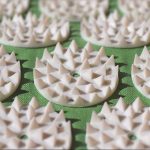It is also helpful to know your BMI, use our BMI calculator to find the answer.
Army Maximum Allowable Body Fat Standards
Age Group: 17-20
- Female 30%
- Male 20%
Age Group: 21-27
- Female 32%
- Male 22%
Age Group: 28-39
- Female 34%
- Male 24%
Age Group: 40+
- Female 36%
- Male 26%
Standard Army Methods for Determining Body Fat Using Body Circumferences, Height, and Weight
B-1. Introduction
a. The procedures for the measurements of height, weight, and specific body circumferences for the estimation of
body fat are described in this appendix.
b. Although circumferences may be looked upon by untrained personnel as easy measures, they can give erroneous
results if proper precautions are not followed. The individual taking the measurements must have a thorough understanding
of the appropriate body landmarks and measurement techniques. Unit commanders will require that designated
personnel have hands-on training and read the instructions regarding technique and location and practice before official
determinations are made. Two members of the unit will be utilized in the taking of measurements, one to place the tape
measure and determine measurements, the other to assure proper placement and tension of the tape, as well as to record
the measurement on the worksheet (DA Form 5500 (Body Fat Content Worksheet (Male) and DA Form 5501 (Body
Fat Content Worksheet (Female)). The individual taking the measurements will be of the same sex as the Soldier being
measured; the individual who assists the measurer and does the recording may be of either sex. The two will work with
the Soldier between them so the tape is clearly visible from all sides. Take all circumference measurements three times
and record them to the nearest 1/2 inch. If any one of the three closest measurements differs by more than 1 inch from
the other two, take an additional measurement and compute a mathematical average of the three measurements with the
least difference to the nearest 1/2 inch and record this value.
c. When measuring circumferences, compression of the soft tissue is a problem that requires constant attention. The
tape will be applied so that it makes contact with the skin and conforms to the body surface being measured. It will not
compress the underlying soft tissues. Note, however, that in the hip circumference more firm pressure is needed to
compress gym shorts. All measurements are made in the horizontal plane (parallel to the floor), unless indicated
otherwise.
d. The tape measure will be made of a nonstretchable material, preferably fiberglass; cloth or steel tapes are
unacceptable. Cloth measuring tapes will stretch with usage and most steel tapes do not conform to body surfaces. The
tape measure will be calibrated-that is, compared with a yardstick or a metal ruler to ensure validity. This is done by
aligning the fiberglass tape measure with the quarter inch markings on the ruler. The markings will match those on the
ruler; if not, do not use that tape measure. The tape will be 1/4- to 1/2-inch wide (not exceeding 1/2 inch) and a minimum
of 5 to 6 feet in length. A retractable fiberglass tape is the best type for measuring all areas. Tapes currently available
through the Army Supply System (Federal Stock Number 8315-00-782-3520) may exceed the 1/2-inch width limits and
could slightly impact on circumferential measurements. Efforts are being made to replace the supply system tape with a
narrower retractable tape. In the interim, the current Army supply system or any other fiberglass tape not to exceed 5/8
inch may be used if retractable tapes cannot be purchased by unit budget funds available and approved by installation
commanders.
B-2. Height and weight measurements
a. The height will be measured with the Soldier in stocking feet (without shoes) and standard PT uniform (gym
shorts and T-shirt), standing on a flat surface with the head held horizontal, looking directly forward with the line of
vision horizontal, and the chin parallel to the floor. The body will be straight but not rigid, similar to the position of
attention. Unlike the screening table weight this measurement will be recorded to the nearest 1/2 inch in order to gather
a more accurate description of the Soldier’s physical characteristics.
b. The weight will be measured with the Soldier in a standard PT uniform (gym shorts and T-shirt). Shoes will not
be worn. The measurement will be made on scales available in units and recorded to the nearest pound with the
following guidelines:
(1) If the weight fraction of the Soldier is less than 1/2 pound, round down to the nearest pound.
(2) If the weight fraction of the Soldier is 1/2 pound or greater, round up to the next whole pound
Want to know how many calories do I burn a day? This is your basal metabolic rate, our BMR calculator will tell you the answer.
Calculator Source: Created by the U.S. Army
If you place 1 pound of muscle next to 1 pound of fat, the muscle would be 22% smaller in size.









